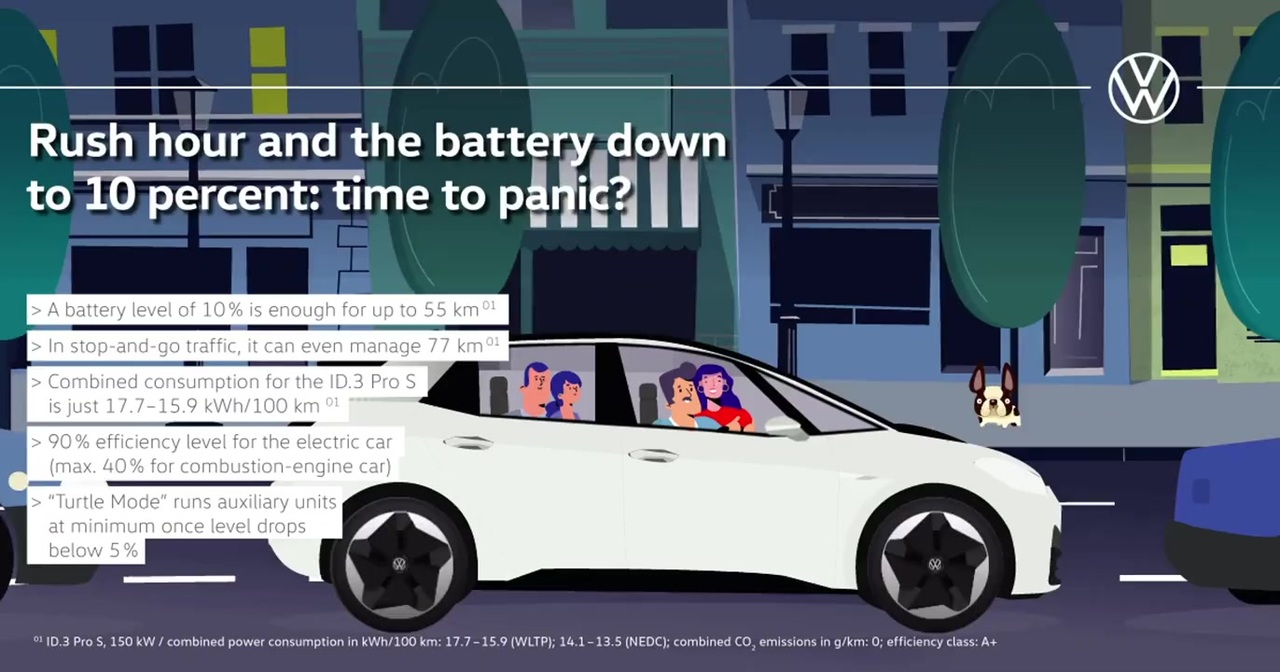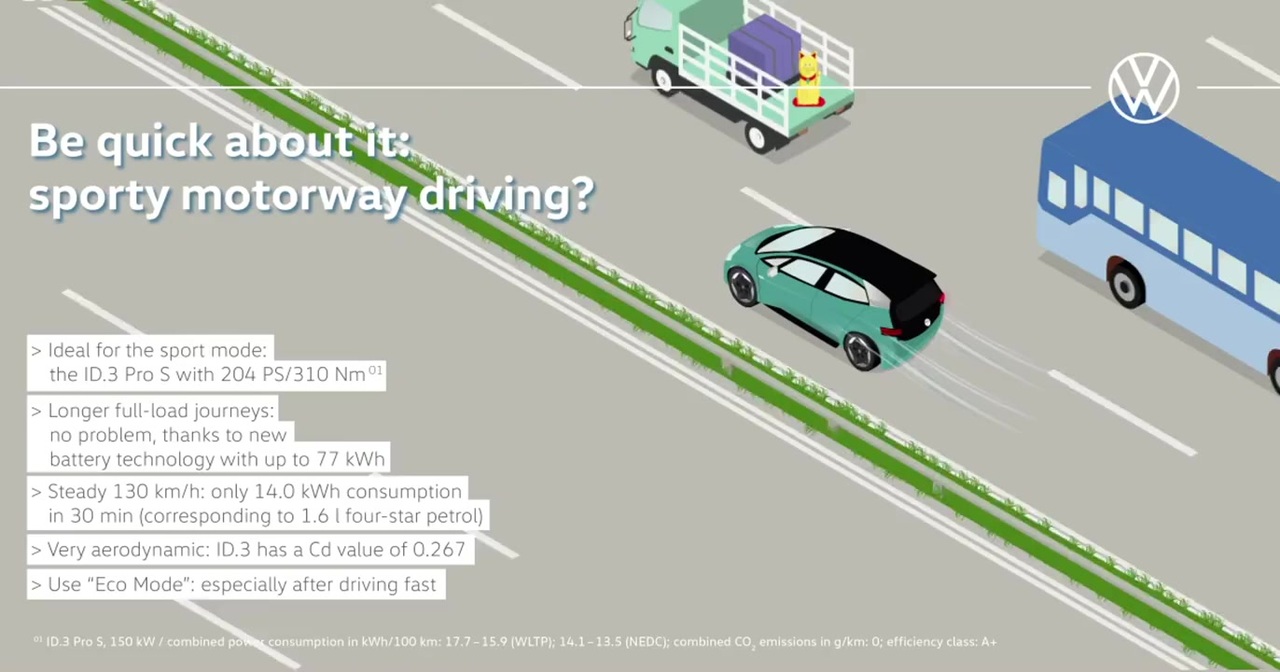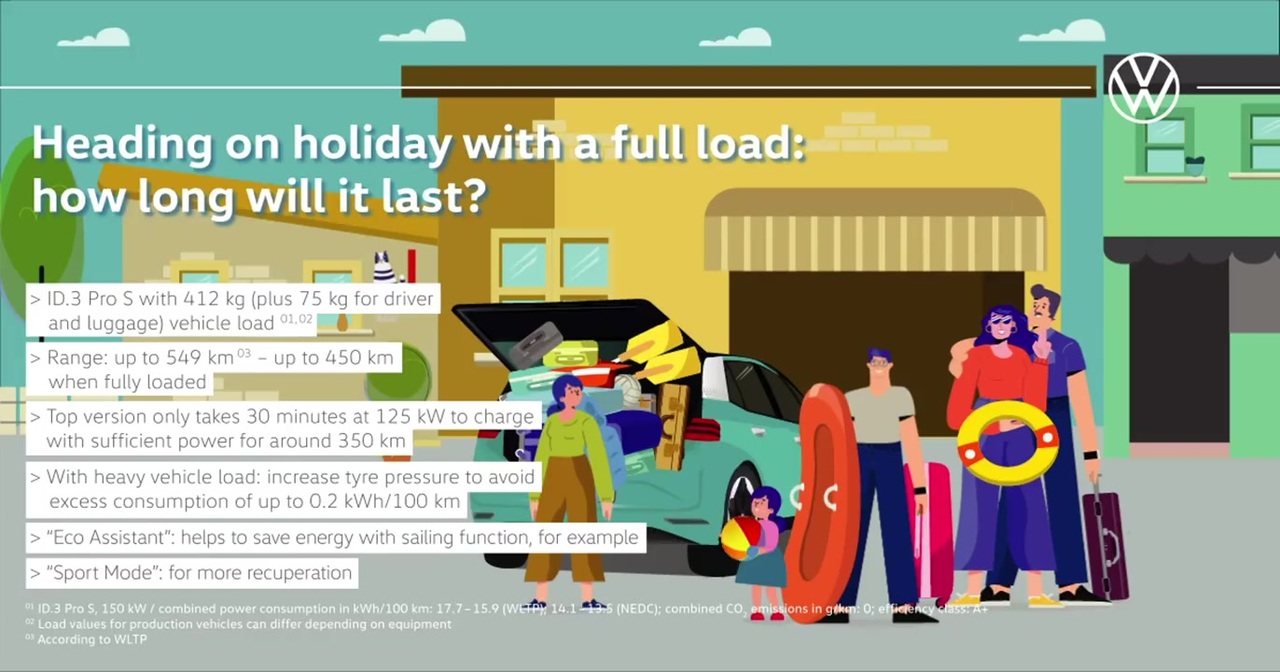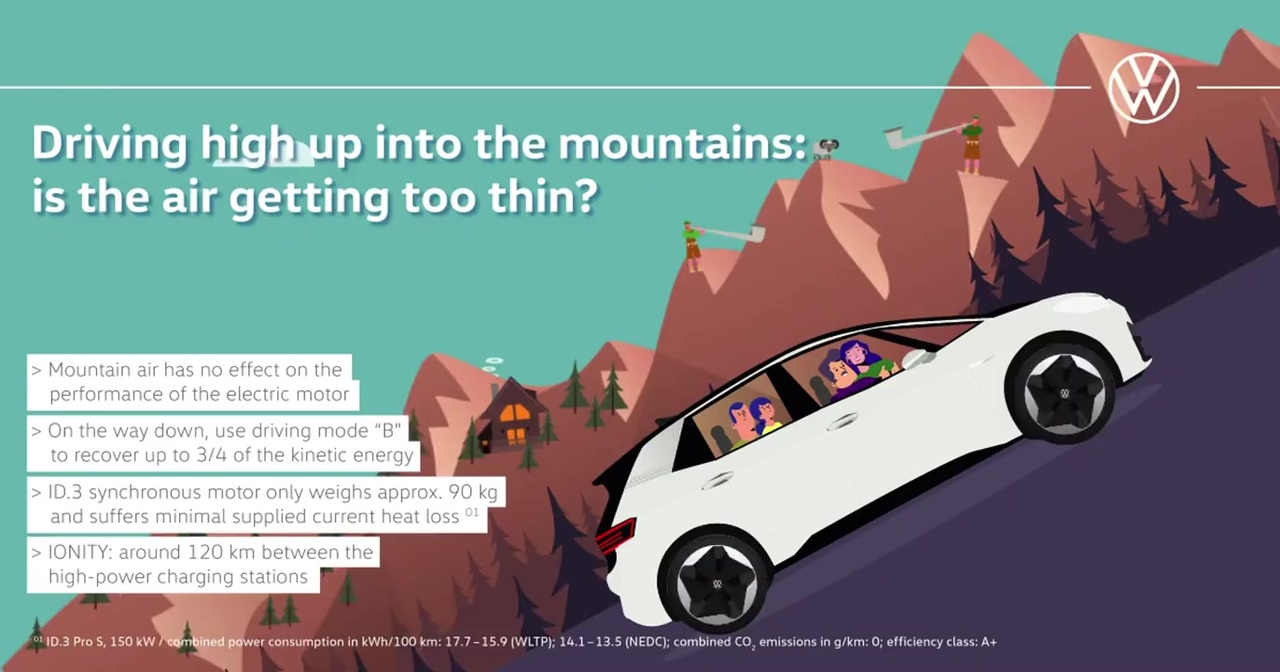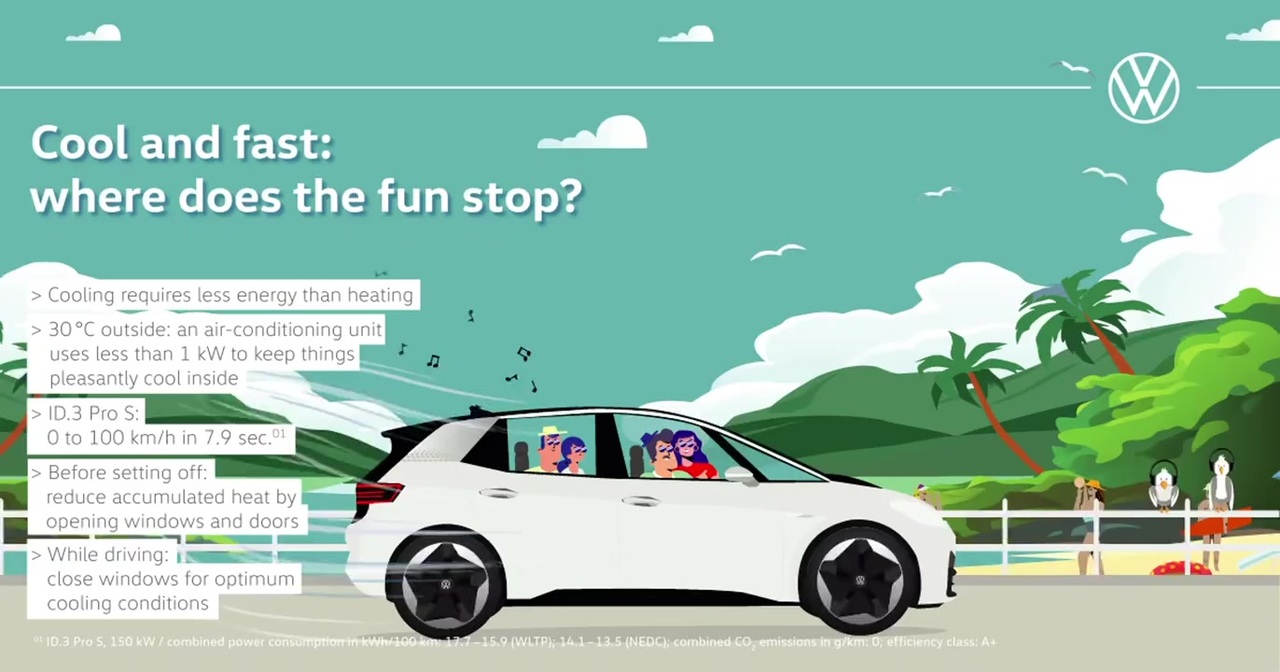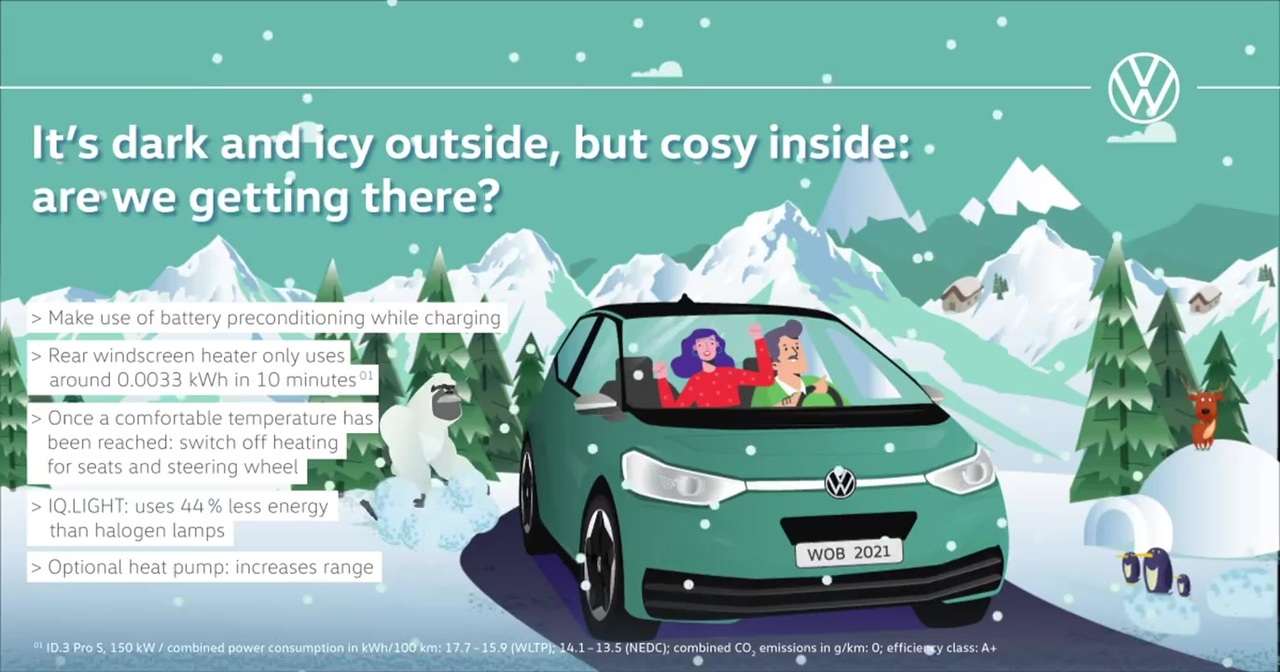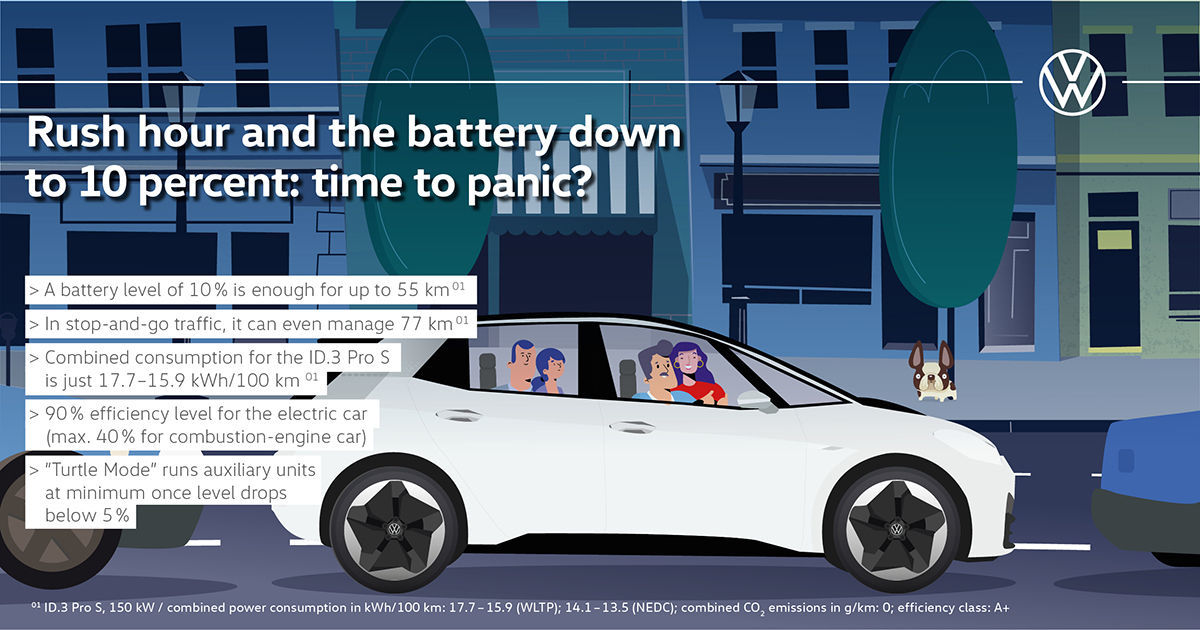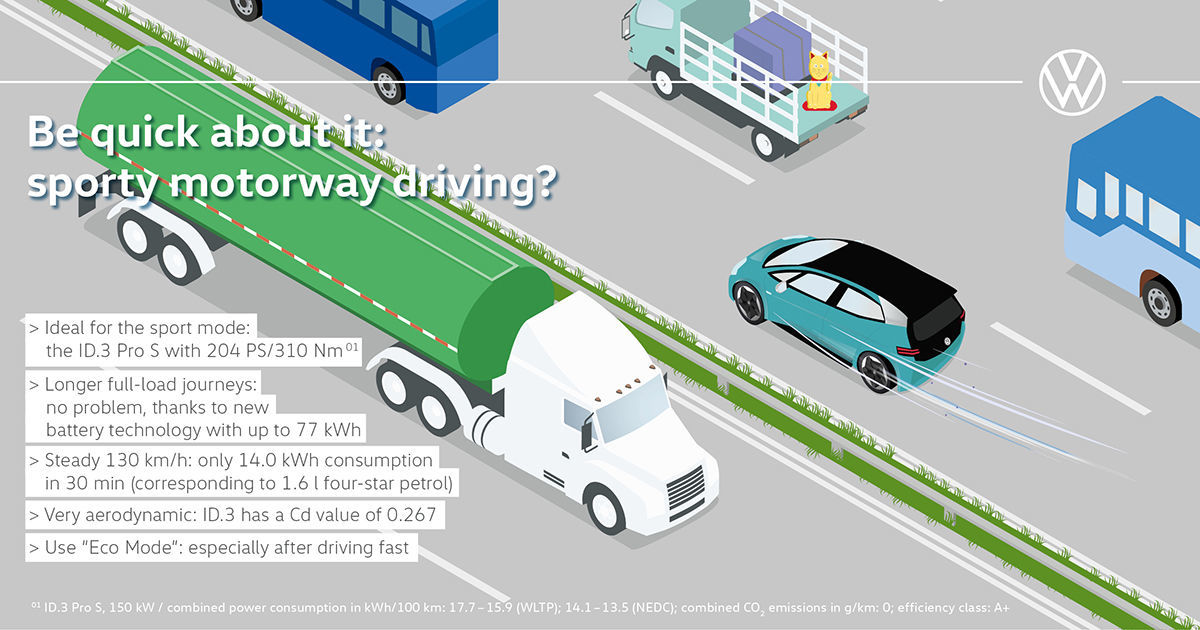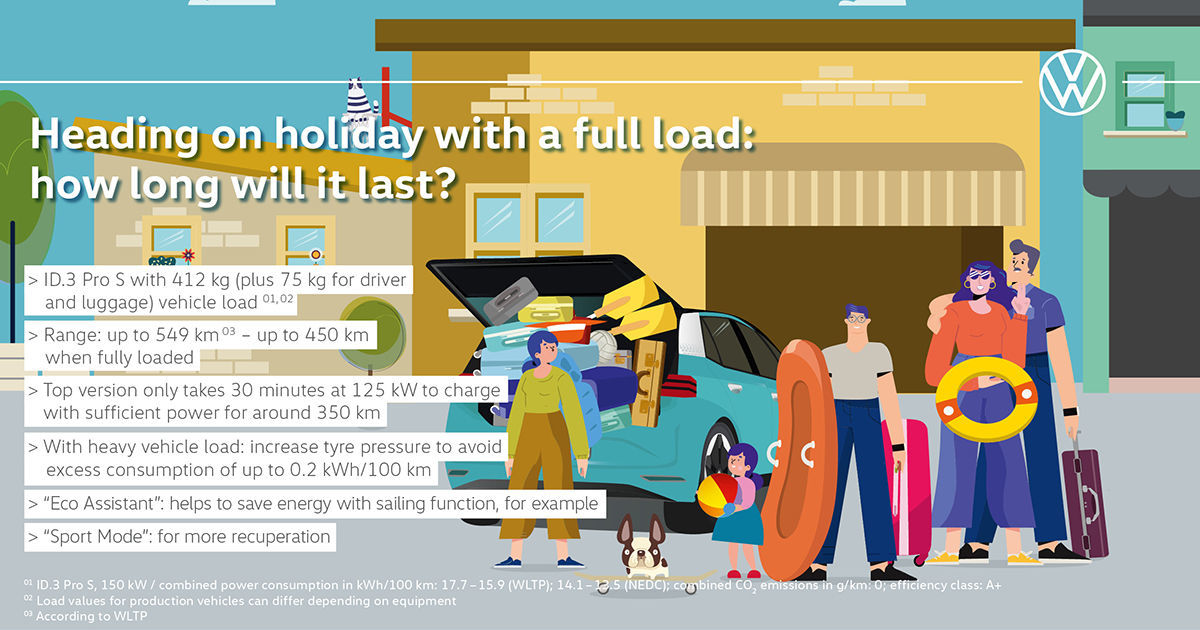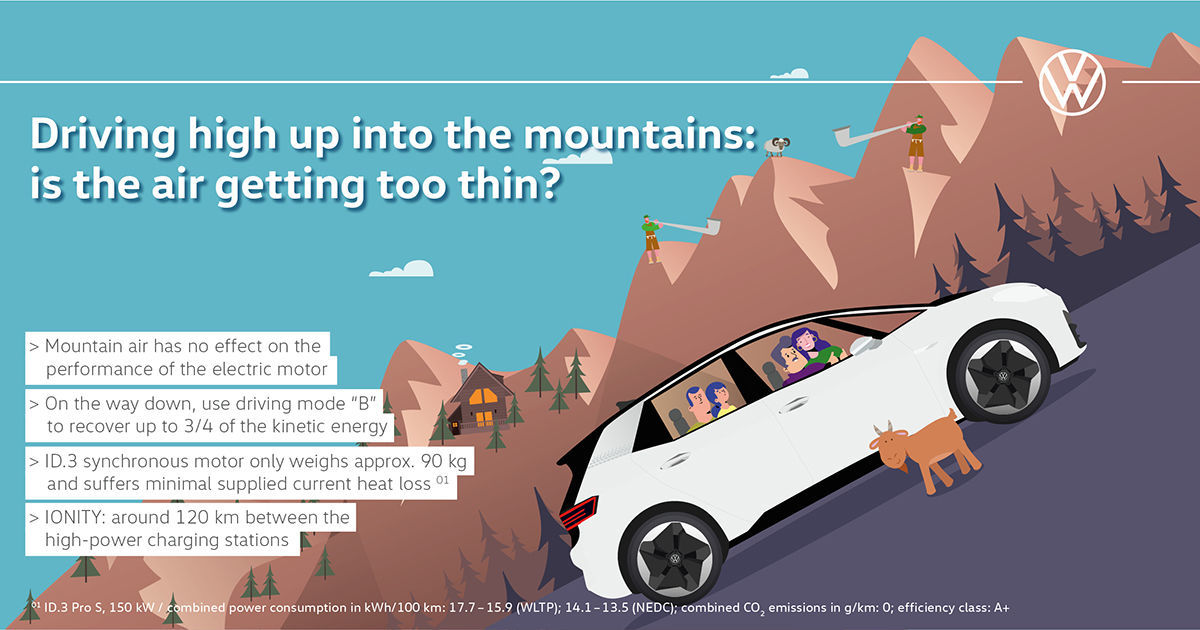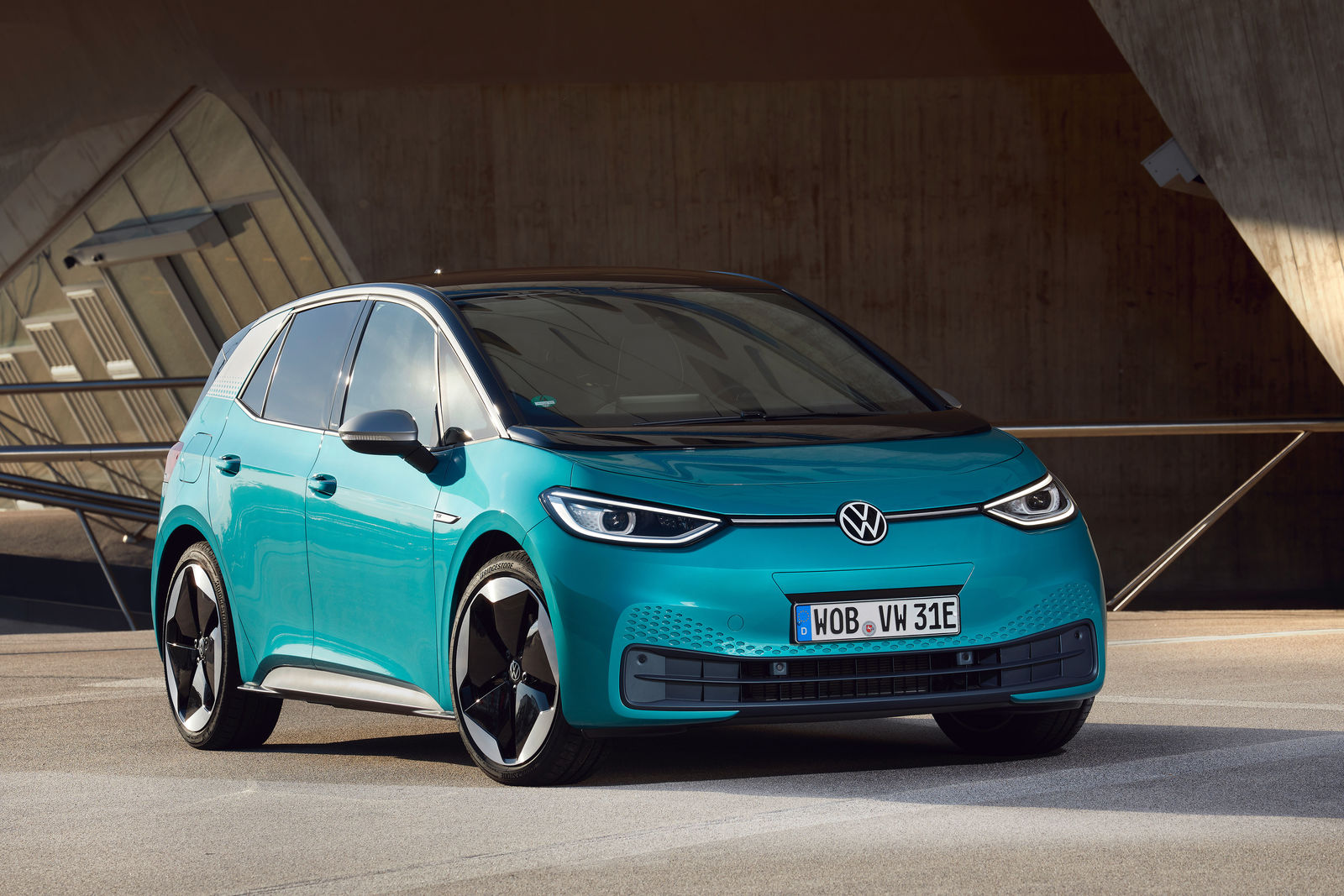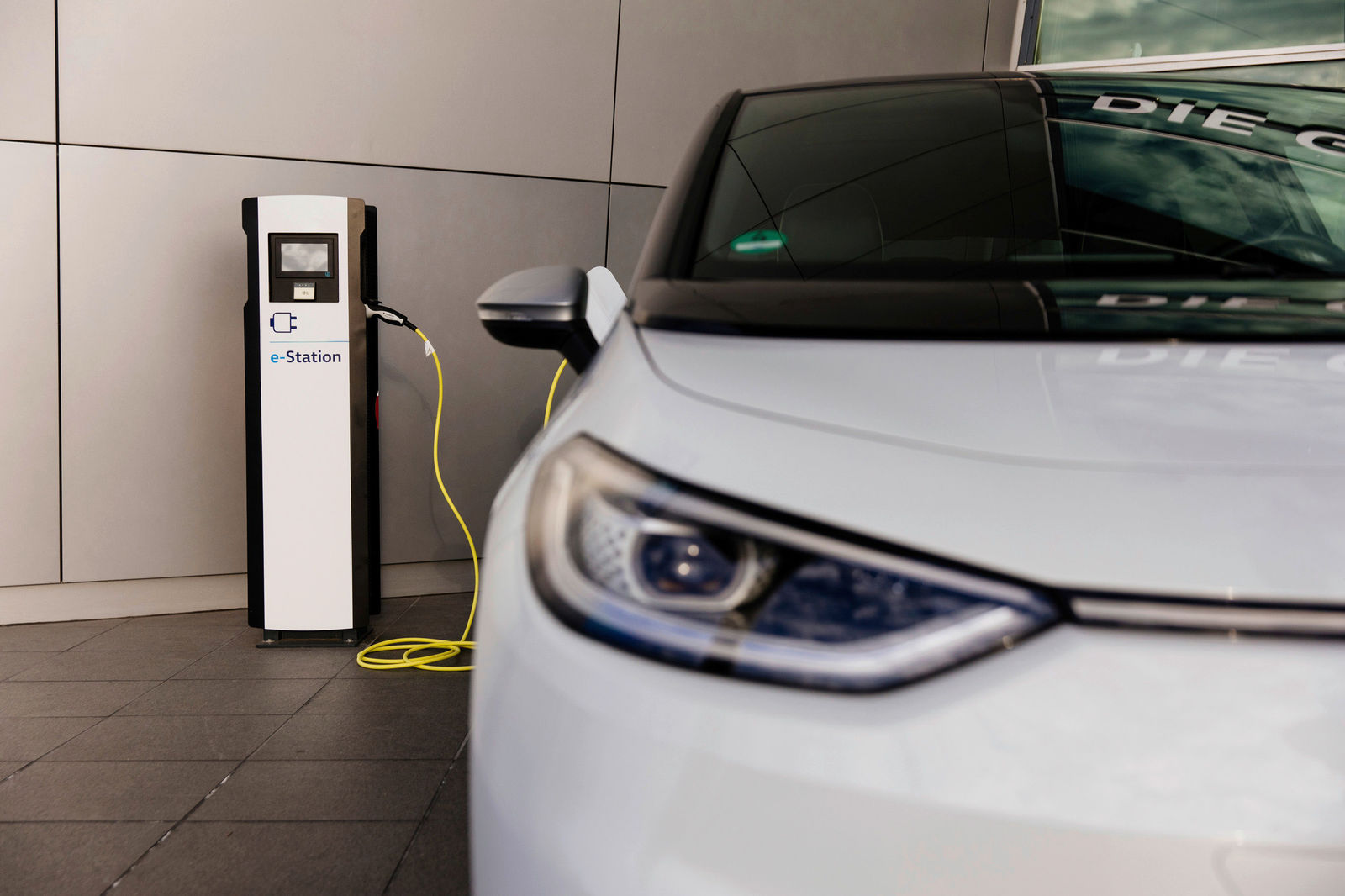City, country, motorway:
let’s see where the ID.3 can take us!
“Range” is no problem for the new, fully-electric models from the ID. family. Thanks to some innovative technology, the ID.3 is ideally suited to dealing with any traffic situation. At the wheel of an electric model, your driving is different, more conscious, more targeted, more efficient – and driving is still fun! This is how!
Rush hour in the city, only 10 % remaining!
No reason to worry: the ID.3 boasts some technical refinements that you can use to keep calm.
With the ID.3 Pro S, a battery charge level of 10 percent still provides a range of around 55 kilometres. Even more than that in stop-and-go traffic. The reason: at speeds of 20–30 km/h, the power consumption level for the ID.3 Pro S is around 10 kWh/100 km (WLTP). The largest battery has a capacity of 77 kWh, meaning that it would be possible to drive 770 kilometres. This would equate to 77 kilometres with a charge level of 10 percent. The average Volkswagen customer drives about 40 kilometres per day. So, this should be sufficient to get a significant majority of commuters to their destination.
Generally, the combined consumption for the ID.3 Pro S is just 17.7 to 15.9 kWh per 100 kilometres. In addition, almost all the energy from the electric motor can be converted into motion energy. The efficiency level for an electric car can reach 90 percent! The maximum level for a car with a combustion engine is 40 percent, with the remainder escaping as heat.
If it looks like the destination may not be reached, it is possible to turn down the performance levels for the heating system, air conditioning or the radio. The intelligent ID.3 battery management system performs this step itself as soon as the battery charge level drops below five percent, entering what is known as “Turtle Mode”.
The proportional consumption of the auxiliary units increases as the average speed decreases. Therefore, stop-and-go traffic has the greatest potential for saving energy - if it comes down to that. You certainly won’t be left standing: cities such as Hamburg, Berlin or Munich are each already home to more than 1,000 charging stations). The Volkswagen brand is significantly expanding the charging infrastructure at its German sites. Some 750 new charging points are planned for next year, including the first High Power Charging stations with up to 300 kW power. Some 2,000 charging points in total are expected to be in operation by the end of 2021 – over 50 percent more than at present.
Reach your destination, fast!
Electromobility is a lot of fun, and it’s anything but slow. Especially when you accelerate! And the ID.3 Pro S with 204 PS and 310 Nm of torque is ideal for that – even during longer fully-loaded journeys on the motorway. The high performance and energy density of the latest lithium-ion battery technology provides optimum performance.
But what happens when you push the “play pedal” a bit harder? Essentially, it's not a problem. But then the consumption level increases - as it would with any combustion engine. With springtime temperatures of 15 degrees, driving at a steady 130 km/h for 30 minutes, results in approx. 14.0 kWh - corresponding to just 1.6 litres of four-star petrol with an internal combustion engine. To use the available energy as efficiently as possible, it is generally recommended to drive at a lower speed of about 120 km/h on motorways.
Overall, the ID.3 Pro S has a range of up to 549 km in the WLTP cycle and remains an efficient electric car with a long range, even with a sporty driving style.
The ADAC refers to electric cars as “long-distance vehicles” if a range of 200 kilometres is realistic. Assuming that the driver exercises sufficient driving discipline, even the mid-range battery package (58 kWh and 420 kilometres according to WLTP) allows for a remarkable 531 kilometres on a single battery charge. Proof of this was delivered by a record-breaking drive from Zwickau to Switzerland with the ID.3 Pro Performance. Alongside the smart battery system and the strong electric motor, this was enabled by the low Cd value of 0.267.
But in the end, the electric vehicle is no different from any other car: variety is the spice of life! After driving fast, switch to the “Eco Mode” to give the battery and the cooling system a break - and to make sure that you arrive at your destination relaxed.
Heading on holiday with a full load: is that a good idea?
Heading on a hard-earned holiday to Paris with kit and caboodle. That is no problem for the ID.3. Time to head off – stow the luggage and make tracks for the summer holidays and 25 degrees in the shade. The journey covers about 900 kilometres of fast motorway driving and picturesque rural roads. The average speed is a relaxed 80 km/h.
The ID.3 Pro S can cope with loads of up to 412 (plus 75 kg for driver and luggage) kilogrammes. That results in a total weight of 2,260 kilogrammes, which does affect the range. Realistically, a fully-loaded car can manage 450 kilometres with the 77 kWh battery. And you also need to make sure that you have the ideal tyre pressure before setting off. Wear and roll resistance increase if this is below the target value; consumption increases by up to 0.2 kWh/100 km, which in turn reduces the range.
However, weight can have a positive effect as it increases the coasting distance. This refers to the distance travelled without expending energy. "Sailing" helps extend the range of the ID.3. Here, the vehicle travels without expending energy. This is generally possible in driving mode "D" and is very easy: you simply take your foot off the accelerator pedal. If the “Eco Assistant” is activated, the high-voltage battery can be recharged with recuperation – the ID.3 does this automatically, taking into account the current driving situation and even the speed limits. It is possible to recover even more energy in “Sport Mode”.
However, one thing is clear: it requires more energy to get the weight moving in the first place. So, it is down to the individual skills of the driver.
Driving to the mountains: the air is getting thinner!
Early morning chill: a weekend trip to the Bavarian Alps. Gradients of over 15 percent are not uncommon, up at around 3,000 metres! The ID.3 can deal with that, even under varying weather conditions and on a range of road surfaces. Unlike purely aspirated engines, the electric motor is not at all affected by the mountain air. In the ID.3, this is an efficient synchronous motor with permanent magnet (PSM), which suffers minimal supplied current heat loss. The electric motor is compact enough to fit in a sports bag, weighing just 90 kilogrammes.
The undulating route is particularly challenging (alternating regularly between climbs and descents) and leads mostly along rural roads. When heading downhill, you can easily take your foot off the play pedal and switch to recuperation mode “B”. This allows up to 3/4 of the kinetic energy to be recovered. Driving in this way – the comfortable “New Drivestyle” – is the exclusive preserve of electric and hybrid vehicles, putting them at a clear advantage compared to the combustion engine.
If the battery level is gradually declining, it is easy to find charging stations all across Europe. Volkswagen is part of the joint venture IONITY, which is currently constructing a high-power charging station every 120 kilometres.
Moving fast at the height of summer
Summer, sun, weekend! Magnificent sunshine outside, so it’s time for a trip to the beach at Timmendorf with the ID.3. Remember the following rule of thumb when using the air-conditioning unit: cooling requires less energy than heating. When the ID.3 is cruising along the beach promenade at 20 km/h and the outside temperature is at 30 degrees, the air-conditioning unit requires less than 1 kW to maintain a pleasant interior temperature. However, such large temperature differentials tend not to be that common. For example, the average summer temperature in Germany was 19.7 in 2019, meaning that it was hardly necessary to switch on the air-conditioning system. For optimum dehumidification, it runs as required in the background, keeping consumption to a minimum.
After a great day at the beach, the plan is to head back home quickly. But the sun has really heated up the interior: it makes sense to release the accumulated heat before driving off. Then switch to the sport mode: the ID.3 Pro S bursts from 0 to 100 km/h in just 7.9 seconds! Better keep the windows shut, so that the air conditioning can work properly. Then onto the motorway to head home at a steady 120 km/h. An ideal speed, which really helps the aerodynamics of the fully-enclosed underbody and the flow-optimised bodywork (similar to a teardrop shape) to take effect.
After returning home, you can charge the ID.3 with a wallbox – as is the case for approx. 80 percent of charging processes. Green energy is available from 32 cents per kWh. Finding a public charging point is also stress-free: The charging infrastructure plan from the German Federal Government specifies precisely 50,000 additional charging points available to the public by 2022. This will be coordinated by NOW GmbH as the national control centre.
It’s dark and icy outside, but cosy inside: are we getting there?
“Driving home for Christmas”: winter has laid a blanket of snow over the landscape and Jack Frost is keeping the outside temperature down around -10 degrees.
First things first: such freezing conditions will affect performance a little. That is just as true for combustion engines (engine takes longer to get to working temperature) as for electric vehicles, as the battery performance suffers a little in extreme cold. However, the integrated battery heater does minimise this effect. The high-voltage PTC unit helps to keep the range up. It converts the electrical energy from the battery directly into heat. In conjunction with the optional heat pump, this makes use of extra heat sources for increased efficiency. 1 kW of electrical energy (battery) is converted into as much as 2.0 kW of heat.
Additionally, the season of cold and darkness means that people make more use of the rear windscreen heater and headlights, which consume more energy, than at other times of the year. For example, if the rear windscreen is coated with rime or frost, the rear heater uses around 0.0033 kWh. Tip: air circulation control is permanently active for the air conditioning system, regulating the proportion of air circulated as required to save heating energy and keep your view clear. We also recommend that you deactivate the heating for the seats and steering wheel once the desired cockpit temperature has been reached, as this saves more energy.
And the general instruction to drive with foresight also applies here. This avoids mechanical braking, allowing recuperation to recover energy instead. A clear view and optimum lighting are crucial in any situation: that is why the ID.3 is equipped with LED headlights as standard. These use around 73 percent less energy than standard halogen headlights. If you choose the optional IQ.LIGHT with the latest LED Matrix headlights, the 48 LEDs provide near-perfect illumination of the road, while using 44 percent less energy.
